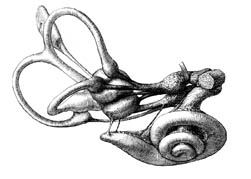
|
|
What Jacob and I have been
discussing for many moons now is the idea of reversing the normally
accepted direction of information streams. Most often this refers to
acoustic information and the essence of our talks might be contained
in some early titles of lectures I gave in the late 90s, for example
"Acoustic Cells and Membranes" Tuebingen 06/12/99, which later
mutated into the rather more science fiction-like, "Membranes in
Space and the Transmitting Ear".
This came out of research in the field of Active Perception. One hardly
need look, or rather hear, any further than the phenomena of Oto-Acoustic
Emissions (OAEs, measurable sounds emerging from the ear), to grasp
that unless some action takes place on the part of the receiver, then
incoming signals may remain unperceived. Due to the active, mechanical
components that go to make up the physiology of the ear, it is possible
to construct a model where certain physical aspects of hearing actually
take place outside the body, at the entrance to the ear.
A much earlier source for our
conversations on reversability sprung from the Pre-Socratics. Some 2500
years ago Empedocles formulated a theory of perception that was significantly
located between two alternative hypotheses. In the case of vision, simply
put, one stated that objects emanated light that shone into the eye.
The other concept was somehow the reverse, that the eye functioned like
a projector, illuminating the object. The thinking of Empedocles embraced
both these notions with the proposition that the eye did indeed engage
the object by casting its gaze upon it. But, at the same time the object
shone back toward the viewer. This opens up the possibility for perception
of the object to be located more or less in between the seer and the
seen, at an interface outside the body where the two streams of light
collide.
The action of simultaneous broadcasting and reception can be modelled
as a contra-flow of information passing through itself, (feedthrough?).
The transmitting ear, with its active mechanisms of receiving, raises
information-theoretical questions about the medium. It is as if our
sense of the world is no more nor less than the resulting interference
patterns of information streaming into and out of our bodies, that the
medium is simply nodal densities of content becoming both the cause
of - and simultaneously being displayed upon - an ethereal skin of interference.
Anthony Moore, Arles 2008
|

